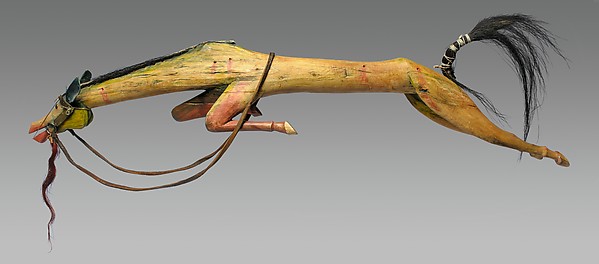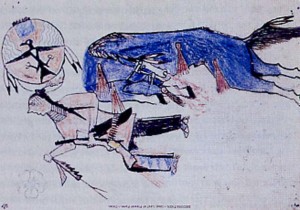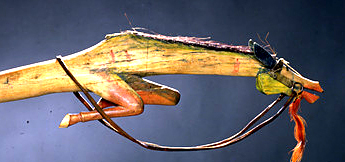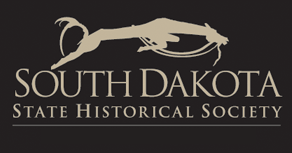
Joseph No Two Horns, He Nupa Wanica (Hunkpapa Lakota), Horse Effigy, c. 1880. Wood (possibly cottonwood), pigment, commercial and native-tanned leather, rawhide, horsehair, brass, iron, bird quill. Length: 38 1/2 in. South Dakota State Historical Society, Pierre.
Joseph No Two Horns‘s Horse Effigy is not only a powerful sculpture, but a portrait of a beloved horse ridden to victory in the Battle of the Little Big Horn. In a recent exhibition of Plains Indian art with hundreds of objects at the Metropolitan Museum in New York, it regularly drew the biggest crowds. His horse’s death in that battle haunted the artist for the rest of his life.
In 1876, No Two Horns or He Nupa Wanica, was a 24 year old Hunkpapa Lakota warrior following his chief and cousin, Sitting Bull, when he fought in the most famous battle of the Great Sioux War. Popularly known as Custer’s Last Stand, it is called The Battle of Greasy Grass by the Lakota. On June 25th, General George Armstrong Custer and his Seventh Cavalry were scouring the Montana territory looking for about 800 “hostiles” as reported by his scouts. Custer expected to easily drive them back into their reservations. Instead, when the Seventh Cavalry attacked what they thought was a small village, Custer and his men found themselves facing the combined forces of thousands of Lakota, Cheyenne, and Arapaho warriors.

Joseph No Two Horns, Death of Blue Roan Horse. c. 1876. Drawing on paper, 8 x 10 “. State Historical Society of North Dakota.
In the battle, No Two Horns’s blue roan suffered seven bullet wounds before collapsing, but not before carrying No Two Horns to victory over the army of General George Custer. For the rest of his life, until his death in 1942, he portrayed this event in colorful drawings and paintings, as well as sculptures.
 This wooden sculpture from 1880 shows his galloping horse is in the midst of battle. It stretches and strains, fighting to keep moving as death nears. His eyes are brass tacks, his leather ears are pulled back. Bullet wounds across his body run red. His mouth is covered in blood and red dyed horse hair dangles to represent blood running from his mouth. Like a skilled animator, No Two Horns pulls the horse’s torso into the long line of its motion path.
This wooden sculpture from 1880 shows his galloping horse is in the midst of battle. It stretches and strains, fighting to keep moving as death nears. His eyes are brass tacks, his leather ears are pulled back. Bullet wounds across his body run red. His mouth is covered in blood and red dyed horse hair dangles to represent blood running from his mouth. Like a skilled animator, No Two Horns pulls the horse’s torso into the long line of its motion path.
The love of horses is an important part of Plains culture and one of the many atrocities of General Custer’s Seventh Army was their systematic slaughter of Plains Indian ponies. The Lakotas were a warrior society and these effigies or Dance Sticks were used in ceremonies and dances to prepare for battle or celebrate victories. This is, however, the only existing Dance Stick that shows the entire body of a horse.
 No Two Horns remains one of the most famous artists of the Plains Indians and his effigies the model for many other Plains artists. Today, his Horse Effigy is not only the most prized object in the collection of the South Dakota State Historical Society but their symbol.
No Two Horns remains one of the most famous artists of the Plains Indians and his effigies the model for many other Plains artists. Today, his Horse Effigy is not only the most prized object in the collection of the South Dakota State Historical Society but their symbol.
While a veteran of more than forty battles, Joseph No Two Horns did not brag about his exploits. In 1926, No Two Horns participated in the ceremonies honoring the 50th Anniversary of the Battle of the Little Big Horn. He said he danced for the ‘soldiers who were so brave and foolish.’
[Thanks to Danyelle Means for corrections to this story.]


There are doubts that this effigy is by No Two Horns. Read the exhibition catalogue entry for “Artists of the Earth and Sky” where David Penney wrote: “The dramatic nature of this horse memorial—its strong visual relationship to the No Two Horns carvings, yet with details of workmanship that suggest a different hand…..”
…..and your statement that this is the only dance stick that shows the entire body of a horse. There was another horse memorial that has the entire body and is the work of No Two Horns……The sculpture was from the Colonel Welch collection, then the Paul Ewald collection and is best known as from the collection of the Gold Seal Co. In addition it is a well known fact that No Two Horn’s horse had seven bullet wounds and the South Dakota horse has only 5 wounds, however the Gold Seal horse has seven and Bob Hollow the known expert on No Two Horns, now deceased, thought the Gold Seal Co. horse as the lst original one made by the artist shortly after the battle while exiled in Canada after the Custer defeat. I draw your attention to articles by David Wooley and George Horse Capture’s article on the artist plus Ian West’s Plain’s Indian Horse Sticks and Plains Indian Horse Effigies plus John Ewer’s “Plains Indian Sculpture”.
The Gold Seal horse memorial is a well kept secret that needs to see the light of day.
Joseph No Two Horns Sculptor to His Horse “Blur Roan” (?) Is a Tribute to the Love & of His Gallantry to “His” Partner
ThanxxYou Joseph No Two Horns